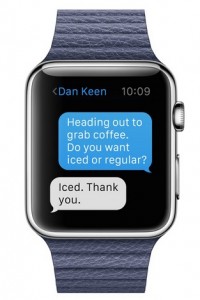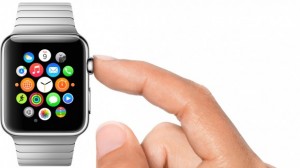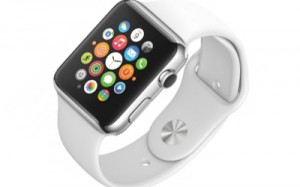There are plenty of people who have been drawn into smartwatch envy by the hype surrounding the imminent arrival of the Apple Watch. Many of these people, who previously hadn’t paid much attention to smartwatches before, are often surprised to discover that the Apple Watch isn’t a stand-alone device, that it needs to be paired with an iPhone in order to operate.
Looking at it from a layman’s perspective, the surprise is understandable. If you are going to spend a rumored $5,000 on a high-end, solid gold Apple Watch, doesn’t it seem a bit ridiculous that the device won’t work unless you also buy a $400 iPhone?
Why The Apple Watch Needs The iPhone
The truth is that all of us would prefer a smartwatch that could stand alone, that didn’t need to be paired with a smartphone or any other device. The problem is that the current state of technology won’t allow it, unless you’re prepared to wear a wallet-sized monster on your wrist.
 It’s not so much a problem of display size. The Apple Watch’s 1.7 inch screen option promises to be pretty versatile and readable. The Apple Watch’s innovative Digital Crown knob on the side allows the user to scroll through long pages of text that can be easily consumed.
It’s not so much a problem of display size. The Apple Watch’s 1.7 inch screen option promises to be pretty versatile and readable. The Apple Watch’s innovative Digital Crown knob on the side allows the user to scroll through long pages of text that can be easily consumed.
The problem is twofold: battery power and computing power. Current technology simply cannot put enough of either into the delicate footprint of the Apple Watch. In fact, just the battery alone takes up most of the Apple Watch’s pricey innards. When you’re talking about the number of apps that most Apple Watch users are going to want, there is no choice. A great deal of this computing power is going to have to take place in a paired iPhone.
The apps will be split in two. Part of the app resides on the watch, while its “extension” on a paired iPhone will handle many of its tasks. For example, health data collected by the Apple Watch gets downloaded and processed on the iPhone.
We now know that a dedicated Apple Watch app will need to be installed on a paired iPhone. This app becomes the main interface for setting up and controlling the Apple Watch. So for the near future, anyway, we’ve got to get used to considering the Apple Watch and the iPhone as two parts making one thing, like peanut butter and jam or Macklemore & Ryan Lewis.
Another Apple Watch Demo
The developers of the Pipes news app have created a neat little “demo” of the Apple Watch, which you can find by clicking here. You can open and navigate the device’s interface by clicking and holding parts of the home screen. Move around a little and you can “try” out some apps like the clock, phone, music and weather apps.
 Clicking on the Digital Crown (as shown in the image to the right) returns you to the home screen, but it doesn’t let you scroll or find other functions. The demo also previews some of the Apple Watch features like Glances, which provides one or two-word bits of your important information. Try it, it’s kinda fun.
Clicking on the Digital Crown (as shown in the image to the right) returns you to the home screen, but it doesn’t let you scroll or find other functions. The demo also previews some of the Apple Watch features like Glances, which provides one or two-word bits of your important information. Try it, it’s kinda fun.
Is Apple Looking At the Luxury Market or Isn’t It?
In a recent blog posting, industry analyst Neil Cybart takes issue with the notion expressed here and elsewhere that Apple’s creation of a $3-5,000 solid gold Apple Watch means that Apple is starting to compete in the luxury goods marketplace. We know that the high-end Apple Watch Edition line will be showing up on fashion runways and in other luxury product settings. Apple itself has taken to referring to the Apple Watch as “jewelry”. So what’s wrong with Apple making luxury products?
 Cybart argues that an Apple Watch “will be just as much a watch as an iPhone is a phone”. He said that no matter the price, the Apple Watch can’t be a luxury phone, it is “a mobile computing facilitator worn on the wrist”, and that the desire to upgrade one’s Apple Watch to an advanced version in the future “will likely be just as strong as it is with iPhone”.
Cybart argues that an Apple Watch “will be just as much a watch as an iPhone is a phone”. He said that no matter the price, the Apple Watch can’t be a luxury phone, it is “a mobile computing facilitator worn on the wrist”, and that the desire to upgrade one’s Apple Watch to an advanced version in the future “will likely be just as strong as it is with iPhone”.
Well we don’t know what kind of world Mr. Cybart lives in, but where we come from, you don’t spend $5,000 on a device only to replace it in three years. He is right that people won’t be handing their Apple Watch down from generation to generation, but we think he is absolutely wrong in thinking that people won’t be looking at the $5,000 Apple Watch as a status symbol.
Because, let’s face it, people who are concerned about status symbols in the first place are not likely to be people who care so much that their beautiful solid gold device no longer has the most up-to-date technology inside. Plus, you’d have to be either crazy or ridiculously wealthy to upgrade your $5,000 wearable device every two or three years, wouldn’t you?
